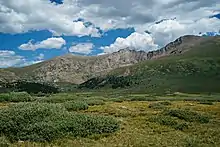| Preceded by the Pleistocene |
| Holocene Epoch |
|---|
 |
|
|
Blytt–Sernander stages/ages
*Relative to year 2000 (b2k). †Relative to year 1950 (BP/Before "Present"). |
The Preboreal is an informal stage of the Holocene epoch. It is preceded by the Tarantian and succeeded by the Boreal. It lasted from 10,300 to 9,000 BP in radiocarbon years or 8350 BC to 7050 BC in Gregorian calendar years (8th millennium BC). It is the first stage of the Holocene epoch. The preboreal oscillation was a short (ca. 150 years) cooling episode within the preboreal.
The Preboreal was an informal subdivision of the Holocene, and as stratigraphy and dating techniques have improved since this 1972 proposal the dates would be different if proposed today. Instead others have begun to use the terms Early, Middle and Late, which would be Lower, Middle and Upper in respect of Holocene sediments. If this terminology were to be used the preboreal would be replaced by Lower Holocene which would be dated 11.7 – 8.2 ka B2K.[1]
In July 2018 the International Commission on Stratigraphy (a part of the IUGS) ratified Greenlandian as the globally recognised first age of the Holocene, much overlapping with the North European regional term Preboreal.[2]
References
- ↑ "Formal subdivision of the Holocene Series/Epoch: a Discussion Paper by a Working Group of INTIMATE (Integration of ice-core, marine and terrestrial records) and the Subcommission on Quaternary Stratigraphy (International Commission on Stratigraphy)" (PDF). Archived from the original (PDF) on 10 August 2017. Retrieved 26 May 2016.
- ↑ International Commission on Stratigraphy. "ICS chart containing the Quaternary and Cambrian GSSPs and new stages (v 2018/07) is now released!". Retrieved 15 July 2018.